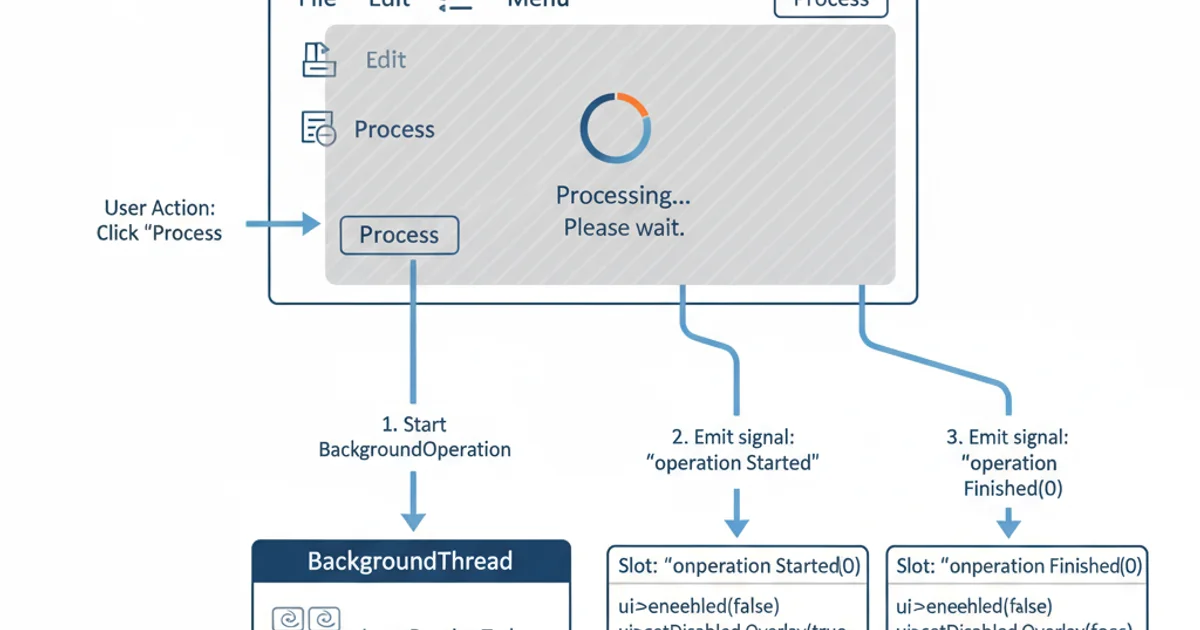Qt to gray out and disable all actions in MainWindow
Categories:
Disabling and Graying Out All Actions in a Qt MainWindow

Learn effective strategies to temporarily disable and visually gray out all interactive elements (actions) within a Qt MainWindow, enhancing user experience during critical operations.
In Qt applications, there are often scenarios where you need to temporarily prevent user interaction with the entire main window or specific parts of it. This is particularly useful during long-running operations, data loading, or when a modal dialog requires exclusive focus. Disabling actions not only prevents accidental clicks but also provides clear visual feedback to the user that the application is busy or in a specific state. This article explores robust methods to achieve this, focusing on Qt4 and its action management system.
Understanding Qt Actions and Their Management
Qt's action system is a powerful mechanism for centralizing application functionality. An QAction object represents a single command that can be triggered from multiple UI elements, such as menu items, toolbar buttons, or keyboard shortcuts. Each QAction has properties like text, icon, shortcut, and crucially, enabled. When an action's enabled property is set to false, all associated UI elements automatically become disabled and typically grayed out, providing consistent visual feedback.
flowchart TD
A[User Initiates Long Operation] --> B{Disable UI Actions?}
B -- Yes --> C[Iterate through QActions]
C --> D{Set QAction.setEnabled(false)}
D --> E[UI Elements Gray Out/Disable]
E --> F[Long Operation Executes]
F --> G{Operation Complete?}
G -- Yes --> H[Iterate through QActions]
H --> I{Set QAction.setEnabled(true)}
I --> J[UI Elements Re-enable]
G -- No --> FFlowchart illustrating the process of disabling and re-enabling UI actions during a long operation.
Method 1: Iterating Through All Actions
The most direct way to disable all actions in a QMainWindow is to iterate through all its children and identify QAction objects. Qt's object model allows you to traverse the object hierarchy using findChildren<T>(). This method is comprehensive as it catches actions directly owned by the QMainWindow as well as those nested within toolbars, menus, and other widgets.
void MainWindow::setAllActionsEnabled(bool enable)
{
QList<QAction *> allActions = findChildren<QAction *>();
foreach (QAction *action, allActions) {
action->setEnabled(enable);
}
}
// Usage:
// To disable all actions:
// setAllActionsEnabled(false);
// To re-enable all actions:
// setAllActionsEnabled(true);
C++ code to enable or disable all QActions within a MainWindow.
Method 2: Disabling the Central Widget or MainWindow Itself
Another approach is to disable the QMainWindow's central widget or even the QMainWindow itself. When a widget is disabled, all its child widgets and their associated actions typically become disabled and grayed out. This can be a simpler solution if you want to block all interaction with the main content area.
void MainWindow::disableMainWindowContent(bool disable)
{
if (centralWidget()) {
centralWidget()->setEnabled(!disable);
}
// Alternatively, to disable the entire window:
// setEnabled(!disable);
}
// Usage:
// To disable content:
// disableMainWindowContent(true);
// To re-enable content:
// disableMainWindowContent(false);
C++ code to disable the central widget or the entire MainWindow.
QMainWindow (setEnabled(false)) can sometimes lead to unexpected behavior with modal dialogs or event processing. Disabling the central widget is often a safer and more targeted approach for content-specific interaction blocking.Considerations for UI Responsiveness
When performing long-running tasks, simply disabling the UI might not be enough. The application's UI thread can still become unresponsive if the task blocks it. For a better user experience, consider running long operations in a separate thread (e.g., using QThread or QtConcurrent) and then re-enabling the UI once the thread signals completion. This ensures the UI remains responsive, allowing users to move the window, minimize it, or even cancel the operation if a dedicated 'Cancel' action remains enabled.

Maintaining UI responsiveness with background threads.